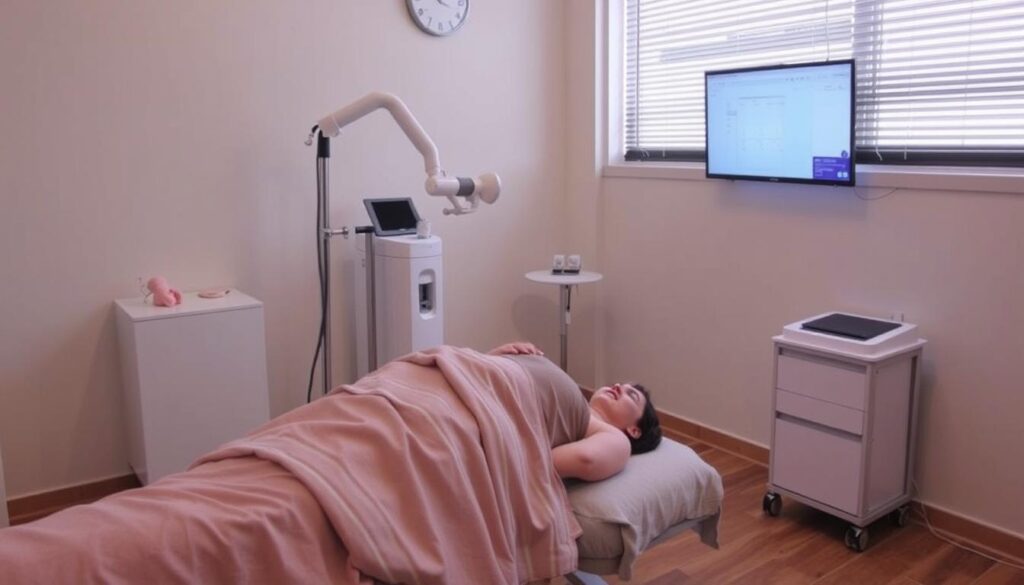I’ve discovered that softwave therapy, also known as extracorporeal shockwave therapy (ESWT), is gaining popularity for its non-invasive approach to treating various medical conditions. This innovative treatment uses acoustic wave technology to stimulate the body’s natural healing processes.
Softwave therapy has been shown to reduce pain and inflammation, improve circulation, and promote tissue repair. As a result, many patients are turning to this cutting-edge treatment for relief from chronic conditions.
The question on many minds is whether insurance covers this innovative therapy. The answer varies depending on the insurance provider, medical necessity, and specific conditions being treated. In this article, we’ll explore the details of insurance coverage, costs, and alternative payment options.
Key Takeaways
- Softwave therapy is a non-invasive treatment that uses acoustic wave technology.
- It helps reduce pain and inflammation, improving circulation and tissue repair.
- Insurance coverage varies depending on the provider and medical necessity.
- Costs and alternative payment options will be discussed.
- Specific conditions being treated affect insurance coverage.
What Is Softwave Therapy and How Does It Work?
Softwave therapy, a non-invasive treatment, utilizes electro-hydraulic supersonic acoustic waves to stimulate healing. These waves travel at 3355 mph into the tissue and/or joint being treated, promoting tissue regeneration and healing at the deepest layers.
This process is based on the principle of mechanotransduction, where the acoustic waves compress and expand cell membranes, mimicking a “trauma” without causing actual damage. This triggers the body’s natural healing response, increasing blood supply to the area and reducing inflammation.
Common Conditions Treated with Softwave Therapy
Softwave therapy is used to treat various conditions, including those related to damaged tissues. By stimulating the activation and recruitment of resident stem cells, it promotes genuine healing of affected tissues.
The Science Behind Softwave Therapy
The effectiveness of softwave therapy lies in its ability to penetrate deep into tissues and joints, reaching areas that other non-invasive treatments might not effectively target. This is achieved through the use of supersonic acoustic waves, which facilitate healing and reduce inflammation.
Is Softwave Therapy Covered by Insurance?
Understanding whether softwave therapy is covered by insurance is crucial for patients considering this treatment option. Currently, SoftWave therapy is being covered by Medicare, as well as some other major insurance carriers.

Medicare Coverage for Softwave Therapy
Medicare coverage for softwave therapy is available, providing relief for patients who are eligible for this program. As a courtesy, some clinics verify all patients’ insurance to determine benefits and coverage.
Private Insurance Coverage Policies
Private insurance coverage for softwave therapy varies widely among different insurance companies and specific plans. Some major insurance carriers have begun covering softwave therapy, but policies are inconsistent and continue to evolve. Coverage often depends on factors such as the specific condition being treated, documentation of medical necessity, and whether other treatments have been attempted first.
It’s essential for patients to work closely with their healthcare providers and insurance companies to determine potential coverage before beginning treatment. Some clinics offer insurance verification services to help patients understand their benefits and coverage options for softwave therapy.
Requirements for Insurance Coverage
Understanding the prerequisites for insurance coverage is crucial for those considering softwave therapy. Insurance companies typically have specific requirements that must be met for softwave therapy to be covered.
Medical Necessity Documentation
One key requirement is medical necessity documentation. This involves a healthcare professional providing evidence that softwave therapy is medically necessary for the patient’s condition. The documentation should include a clear diagnosis, the recommended treatment plan, and an explanation of how softwave therapy will benefit the patient.
Qualified Provider Requirements
Another crucial factor is that the therapy must be administered by a qualified healthcare provider. This typically means the provider should be licensed, have appropriate training in softwave therapy, and work in a clinical setting that meets certain standards.
To ensure coverage, it’s essential to verify that your chosen provider meets these qualifications. Some insurance companies also maintain networks of approved providers, and seeking treatment outside these networks may affect coverage.
| Provider Qualifications | Clinical Setting Requirements |
|---|---|
| Licensed healthcare professional | Clinical setting that meets insurance standards |
| Appropriate training in softwave therapy | Equipment and staff meeting specific criteria |
As noted by a healthcare expert, “Verifying that your provider is within your insurance network and meets all necessary qualifications is a critical step in ensuring that your softwave therapy is covered.”
“Verifying that your provider is within your insurance network and meets all necessary qualifications is a critical step in ensuring that your softwave therapy is covered.”

The Cost of Softwave Therapy Without Insurance

Understanding the cost of Softwave therapy is crucial for patients considering this treatment option. Softwave therapy is a non-invasive treatment that stimulates healing and reduces pain.
Average Session Costs
The average cost per session of Softwave therapy can vary, but a typical session may cost between $200 to $400. The exact cost depends on several factors, including the condition being treated and the location of the treatment provider.
Complete Treatment Plan Pricing
A complete treatment plan for Softwave therapy usually includes six to twelve sessions, with total costs ranging from $1,200 to $2,400. After 6-8 treatments, patients often reach maximum stem cell production, which continues to promote healing for 8-12 weeks after the final session.
Key Points to Consider:
- A full treatment plan typically ranges from $1,200 to $2,400.
- The number of sessions varies depending on the condition and individual response to therapy.
- Sessions are often spaced out over several weeks to allow for optimal healing.
- The long-term benefits of Softwave therapy can make it a valuable investment for many patients.
How to Check If Your Insurance Covers Softwave Therapy
Understanding your insurance coverage for Softwave Therapy involves direct communication with your provider. To navigate this process effectively, it’s essential to be informed and prepared.
Questions to Ask Your Insurance Provider
When inquiring about Softwave Therapy coverage, there are several key questions to ask your insurance provider. These include:
- Is Softwave Therapy covered under my current plan?
- Are there any specific conditions or diagnoses that must be met for coverage?
- What are the out-of-pocket costs associated with Softwave Therapy?
Asking these questions can help clarify your coverage and any potential costs.
Working with Your Healthcare Provider
Collaborating with your healthcare provider is crucial in maximizing the chances of insurance coverage for Softwave Therapy. Your provider can help document medical necessity, which is often required for coverage. This includes detailing previous treatments attempted and why Softwave Therapy is an appropriate next step.
| Key Factors | Description | Importance |
|---|---|---|
| Medical Necessity | Documentation of the need for Softwave Therapy | High |
| Provider Experience | Your provider’s experience with insurance coverage for Softwave Therapy | Medium |
| Clear Communication | Ensuring clear dialogue between you, your provider, and the insurance company | High |

Alternative Payment Options for Softwave Therapy
While insurance coverage for softwave therapy varies, patients can explore other financial avenues to make the treatment more affordable. For those who cannot or do not have insurance coverage for this therapy, alternative payment options can help manage the costs.
Health Savings Accounts (HSAs) and Flexible Spending Accounts (FSAs)
Patients with HSAs or FSAs can use these accounts to pay for softwave therapy treatments. These accounts allow individuals to set aside pre-tax dollars for medical expenses, potentially reducing the financial burden of therapy.
Payment Plans and Financing Options
Many healthcare providers offer in-house payment plans that allow patients to spread the cost of treatment over several months without interest. Additionally, third-party medical financing options like CareCredit or Lending Club may offer promotional interest-free periods. Patients should understand all terms, including interest rates and payment periods, before committing to any financing option.

Comparing Softwave Therapy to Other Treatments
Comparing Softwave Therapy to other treatments can help patients make informed decisions about their care. Softwave Therapy is a non-invasive treatment that promotes healing and provides relief from chronic pain.
Softwave Therapy vs. Surgery
Softwave Therapy offers a non-surgical alternative for treating chronic pain. Unlike surgery, it doesn’t require incisions or lengthy recovery times, making it an attractive option for those seeking to avoid invasive procedures. Softwave therapy stimulates healing and can be more cost-effective in the long run.
Softwave Therapy vs. Injections
While injections can provide temporary relief, Softwave Therapy addresses the underlying cause of pain, promoting long-term healing. This reduces the need for repeated injections and the associated risks. Softwave therapy is a safer, more sustainable option for managing chronic pain.
Softwave Therapy vs. Medication
Medications often provide temporary symptom relief but can lead to dependency and side effects. Softwave Therapy, on the other hand, promotes actual healing without the risks associated with long-term medication use. With a potential lifetime cost of up to $70,000 for medication, Softwave Therapy can be a more economical choice. 
Benefits of Choosing Softwave Therapy
Softwave therapy offers a multitude of benefits for individuals seeking relief from pain and improved function. This treatment modality has gained attention for its effectiveness in addressing various musculoskeletal conditions.
Non-Invasive Treatment with Minimal Recovery Time
One of the significant advantages of softwave therapy is its non-invasive nature, allowing patients to undergo treatment without the risks associated with surgical interventions. Minimal recovery time is required, enabling individuals to return to their daily activities promptly. This aspect makes it an attractive option for those who cannot afford lengthy downtime.
Long-Term Results and Effectiveness
Softwave therapy is backed by research showing long-term results with success rates ranging from 65-91% for musculoskeletal disorders. By stimulating the body’s natural healing processes and promoting stem cell recruitment, softwave therapy addresses the root causes of pain and dysfunction, leading to more sustainable outcomes.
The benefits of softwave therapy continue to develop over time, with healing processes persisting for 8-12 weeks after the final session. This prolonged healing response is attributed to the migration of stem cells and the repair of damaged tissues.
| Condition | Success Rate | Recovery Time |
|---|---|---|
| Musculoskeletal Disorders | 65-91% | Minimal |
| Chronic Pain | Significant Relief | Variable |
As noted by a medical professional, “Softwave therapy represents a significant advancement in the treatment of musculoskeletal conditions, offering patients a non-invasive and effective solution for achieving long-term relief.”
“The therapy has been shown to promote genuine tissue healing and regeneration, rather than just masking symptoms.”
By choosing softwave therapy, patients can experience significant long-term improvements in pain levels and function. The therapy’s ability to stimulate natural healing processes makes it a valuable treatment option for those seeking a holistic approach to pain management.

Conclusion
As we’ve explored, insurance coverage for Softwave Therapy varies, but patients have several options to access this innovative treatment. While coverage decisions depend on several factors, including medical necessity and provider qualifications, alternatives like HSAs/FSAs and payment plans can help. Softwave Therapy offers a non-invasive solution with minimal recovery time, providing relief and promoting healing. Patients should consult their healthcare providers and insurance companies to determine the best path forward. For many, Softwave Therapy is a valuable investment in their health.
FAQ
What is softwave therapy, and how does it work?
Softwave therapy is a non-invasive treatment that uses acoustic waves to stimulate natural healing processes, reduce inflammation, and relieve pain. It promotes the activation of stem cells, enhancing the body’s ability to repair damaged tissues.
What conditions can be treated with softwave therapy?
Softwave therapy is commonly used to treat musculoskeletal conditions, such as chronic pain, sports injuries, and soft tissue damage. It is also effective in promoting wound care and reducing inflammation.
How do I know if my insurance covers softwave therapy?
To determine if your insurance covers softwave therapy, you should contact your insurance provider directly and ask about their coverage policies. You can also work with your healthcare provider to verify coverage and understand the requirements for medical necessity documentation.
What are the requirements for insurance coverage of softwave therapy?
Typically, insurance coverage for softwave therapy requires medical necessity documentation and treatment by a qualified healthcare provider. You should check with your insurance provider to understand their specific requirements.
How much does softwave therapy cost without insurance?
The cost of softwave therapy without insurance varies depending on the provider, location, and treatment plan. On average, a single session can range from a few hundred to several hundred dollars. Complete treatment plans may be available at a discounted rate.
Are there alternative payment options available for softwave therapy?
Yes, alternative payment options, such as Health Savings Accounts (HSAs) and Flexible Spending Accounts (FSAs), may be used to cover the cost of softwave therapy. Some providers also offer payment plans and financing options to make treatment more accessible.
How does softwave therapy compare to other treatments?
Softwave therapy is a non-invasive treatment option that offers minimal recovery time and long-term results. Compared to surgery, injections, or medication, softwave therapy provides a safe and effective alternative for managing chronic pain and promoting healing.
What are the benefits of choosing softwave therapy?
The benefits of softwave therapy include non-invasive treatment, minimal recovery time, and long-term results. It is an effective option for managing chronic pain, promoting healing, and enhancing overall well-being.





